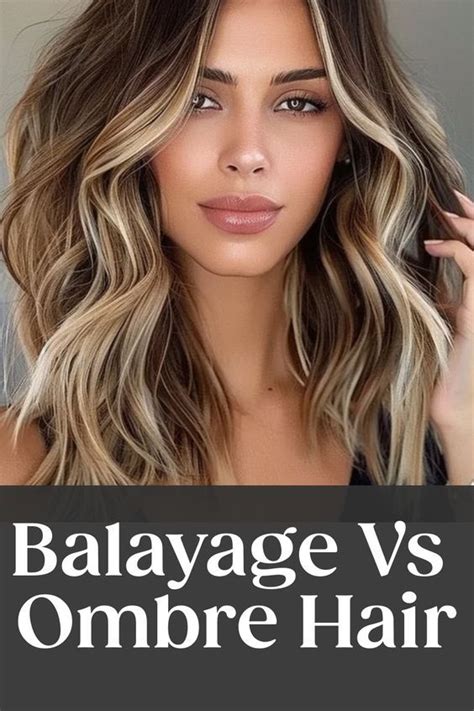Balayage and ombre are two of the most popular hair coloring techniques that have taken the beauty industry by storm. Both techniques create a stunning gradation of color, but they differ in their application and overall effect. This comprehensive guide will delve into the nuances of balayage and ombre, helping you decide which technique is best suited for your hair and desired look.

Balayage: A Natural, Sun-Kissed Glow
Balayage is a French hair coloring technique that translates to “to sweep.” It involves hand-painting color onto small sections of hair, creating a natural, sun-kissed glow. Balayage is typically applied to the mid-lengths and ends of the hair, leaving the roots untouched. This creates a seamless blend of colors, giving the illusion of natural highlights.
Key Features of Balayage:
- Focuses on freehand application
- Creates a subtle, sun-kissed effect
- Low-maintenance and requires less touch-ups
- Suitable for all hair colors and textures
Ombre: A Gradual Fade from Dark to Light
Ombre, French for “shadow,” is a hair coloring technique that involves a gradual transition from a darker shade at the roots to a lighter shade at the ends. The color gradient is created by applying bleach or color to the hair in sections, leaving the roots untouched. Ombre can range from subtle to dramatic, depending on the contrast between the two shades.
Key Features of Ombre:
- Involves a more structured application
- Creates a visible color gradient
- Requires more maintenance and touch-ups
- Suitable for dark-haired individuals
Balayage vs Ombre: A Comparative Analysis
| Feature | Balayage | Ombre |
|---|---|---|
| Application | Freehand painting | Sectioned bleaching |
| Effect | Natural, subtle highlights | Gradual color gradient |
| Maintenance | Low-maintenance | Requires more frequent touch-ups |
| Versatility | Suitable for all hair colors and textures | Best suited for dark hair |
Which Technique is Right for Me?
The best hair coloring technique for you depends on your desired look, hair color, and lifestyle. Here’s a guide to help you choose:
- For a natural, sun-kissed glow: Balayage is the ideal choice, as it creates a subtle and low-maintenance effect.
- For a dramatic color transformation: Ombre is a better option, as it allows for a more visible color gradient.
- For dark hair: Ombre can be more flattering on dark hair, as it creates a stark contrast between the roots and ends.
- For frequent touch-ups: If you prefer low-maintenance hair color, balayage is a better choice, as it requires less frequent touch-ups.
Tips for Achieving the Perfect Balayage or Ombre
- Consult an experienced hairstylist: A skilled hairstylist can assess your hair and create a customized color plan to achieve your desired look.
- Consider your hair type and texture: Balayage is more suitable for fine or medium hair, while ombre can work well on both fine and coarse hair.
- Protect your hair: Both balayage and ombre involve chemical processing, so it’s essential to protect your hair from damage. Use heat protectant products and deep condition your hair regularly.
- Maintain your color: To keep your balayage or ombre looking fresh, touch up the color as needed. Use color-protecting shampoos and conditioners, and avoid over-washing your hair.
Creative Applications of Balayage and Ombre
Beyond traditional applications, balayage and ombre can be used to create a wide range of creative hair colors. Here are some innovative ideas:
- Reverse ombre: This technique inverts the traditional ombre pattern, with the darker shade at the ends and the lighter shade at the roots.
- Multi-dimensional balayage: This technique uses multiple shades of highlights to create a rich and complex color effect.
- Peekaboo ombre: This subtle technique involves adding a pop of color to the underside of the hair, creating a hidden highlight that’s only visible when the hair is pulled back or styled.
- Colormelt ombre: This technique blends multiple shades seamlessly to create a gradient that resembles a melted sunset.
Frequently Asked Questions (FAQs)
Q: Which technique is more permanent?
A: Ombre is generally more permanent, as it involves bleaching the hair. Balayage, on the other hand, uses a gentler technique that fades more gradually.
Q: Can I do balayage or ombre at home?
A: While it’s possible to attempt balayage or ombre at home, it’s highly recommended to leave these techniques to experienced hairstylists. Incorrect application can lead to uneven or unnatural color results.
Q: How often should I touch up my balayage or ombre?
A: Touch-ups depend on the desired frequency of the color change. For subtle balayage, touch-ups may be needed every 6-12 months. For ombre, touch-ups may be required every 4-8 weeks.
Q: Can I change my hair color after balayage or ombre?
A: Yes, but it’s important to wait a few weeks after the initial treatment to allow your hair to rest. Consult with your hairstylist for guidance on the best timing and approach for changing your hair color.
Conclusion
Balayage and ombre are both stunning hair coloring techniques that offer unique benefits. Whether you prefer a natural, sun-kissed glow or a dramatic color transformation, there’s a technique that can help you achieve your desired look. By understanding the key differences between balayage and ombre, consulting with an experienced hairstylist, and following proper care instructions, you can enjoy beautiful, vibrant hair color that complements your style and personality.
